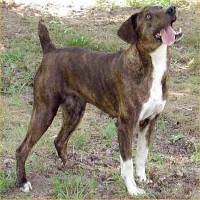Appearance of the Mountain Cur
|
| The Cur dog was the first true, distinct, American thoroughbred. The earliest lines can be traced throughout the southern United States, particularly near the Appalachian Mountains. Settlers brought European dogs, mainly hunting dogs and terriers. These dogs were crossed with native dogs, the most notable of which was the Cur Indian, and this unique type was born. The dogs have excellent scenting ability and a clear, powerful bay (although most Curs are known for their chops, and Hounds have a distinct bawl). Terrier blood adds grit and tenacity to which no other type of dog could compare. Both the Hound and the Terrier are still unsurpassed to this day in quality compared to other dogs. Although not considered a true shepherd type, the Cur also shared the ancestry of the shepherd, particularly the Beauceron. Although not a traditional breeder, the Cur was used to round up cattle. Texas Longhorn cattle and feral hogs were what this dog had to handle, not normal cattle or sheep. |
Temperament of the Mountain Cur
|
| The modern Cur is still a traditional hunting dog. Still seen almost exclusively in the South, this farm dog is incomparable. It can handle anything from squirrels and raccoons to bears, wild boar and bulls. What's more, it's a first-class tree dog. They are also above-average trackers, although not as effective as the Coonhound and not vocal on trails. Curs are also very possessive and protective of their family, a trait found in terriers and often in shepherds, but certainly not in dogs. As a result, they make excellent guard dogs. However, it should be noted that this breed is generally unsuitable as a pet. Although friendly and loyal, like most hunting dogs, the Mountain Cuckoo's true nature lies in the hunt, not in the home. Many people introduce other breeds into the Mountain Cur, however, with the exception of the dog's fine nose, this is unnecessary as a good dog should have all the traits of a hunting dog. It has been recognized within its own registry, the OMCBA, or the Mountain Goat Breeders Association and the United Kennel Club. |
Needs and activities of the Mountain Cur
|
| The Mountain Cur is not recommended for apartment living. It is bred for work and will be happiest with a job to do. The Mountain Cur is a very active working dog that needs plenty of daily exercise. When you're not hunting, you need to go for a daily walk or jog, long and fast. When walking, the dog should be heeled beside or behind the person holding the leash, because in a dog's mind, the leader leads the way, and that leader must be the human. What's more, he'll benefit from a large safety zone where he can circulate freely. This breed loves outdoor activities and sports. |
Maintenance of the Mountain Cur
|
| The Mountain Cur is relatively easy to groom, except when it sheds seasonally, usually once or twice a year. Brush him with a natural bristle brush, a soft brush or a protective glove to remove loose or dead hairs. Weekly brushing will keep his coat and skin healthy and shiny. He may experience dry skin or dandruff if over-bathed. Only bathe him a few times a year with a mild dog shampoo and rinse well with clean, lukewarm water. The Mountain Cur is not a hypoallergenic dog. He doesn't drool much either, as he has tighter lips and not the typical jowls. Since he has floppy ears, check them every week and clean them as needed to avoid any stench or infection. If he's very active and runs over rough terrain, he should naturally have normal nails. However, you should check his nails every few weeks to make sure they're properly worn, even the dewclaws. |







 English (United Kingdom)
English (United Kingdom)